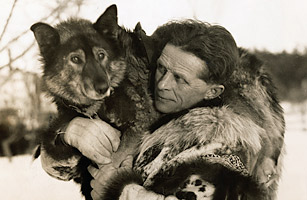Leonard Seppala

Leonard Seppala and Togo
The first sled driver to gain notoriety on the sled dog circuit using Siberian Huskies was a Norwegian named Leonard Seppala who had emigrated to Alaska early in the twentieth century. He inherited a well-trained team of huskies that had originally been scheduled to drive explorer Ronald Amundsen to the North Pole. When the expedition was cancelled due to the outbreak of World War 1 the dogs were replaced with Seppala. Over the next few years his Siberian Husky teams beat all comers in races throughout the Northwest.
His huskies were all but unbeatable in the 25 mile Borden Cup that took place each year in Nome.
In 1925, a severe diphtheria epidemic swept the remote city of Nome, Alaska. Seppala and other sled dog drivers coordinated relays using their Husky teams to transport urgently needed antitoxin and other medical supplies more than 600 miles. This historic “serum run” quickly brought the Siberian Husky into the public’s attention across the United States. Seppala and his team participated in invitational races in New England, and the breed’s unique capabilities and endearing temperament rapidly captured the respect of sportsmen and women nationwide. Even today, a statue of Balto, the lead dog of the team that took the last leg of the serum relay, sits in Central Park in New York City, dedicated to all dogs who participated in that heroic relay. The breed was accepted by the American Kennel Club in 1930. A number of Sibs were assembled at the Chinook Kennels in New Hampshire and used on the Byrd expeditions to Antarctica. Siberian Huskies also were used by the US military during World War II as part of its Arctic Circle search-and-rescue unit.
|
News reports of the feats of Seppala's dogs brought great admiration and acclaim to the breed. It created a demand for Siberian Huskies, especially by sledding enthusiasts in New England. Because the breeders in Alaska were unable to fill the requests they received many interested fanciers imported dogs from Siberia. These proved to be the last substantial imports before the breed disappeared in the homeland.
Today's most famous dogsled race is the IDITAROD annual race from Anchorage to Nome, and it commemorates the historic journey of Leonhard Seppala and his Siberian Huskies. The course is more than 1,100 miles. To date, the best Alaskan Husky team has completed the Iditarod race in 10 days. Another important race is the YUKON QUEST, a race named after the Yukon River, "The highway of the North". It starts in Fairbanks and is supported by the efforts of hundreds of individuals.
|
